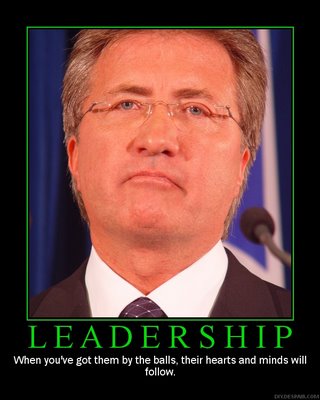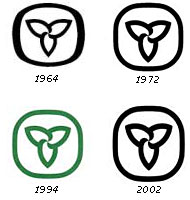At the outset, let's make it clear what Danny Williams announced
yesterday and what he didn't.
He announced a new logo for the Government of Newfoundland and Labrador, to replace the shield from the coat of arms that has been used for the past 15 years.
A logo is nothing more than the visual identity. It's the sign or symbol that helps distinguish a particular product, company or organization from the multitude of other similar things out there competing for attention.

Danny announced a logo (
right).
Logo versus brandNike's swoosh is a logo. It is the way potential athletic apparel consumers find a Nike product on a shelf or a rack. Nike advertising is designed to do a couple of things, one of which is train people to identify the logo.
Ford has had the same logo since the first Model A rolled off the assembly line. It's the word FORD in a blue oval.
No one - except the odd bobble head - buys a pair Nike running shoes or a Ford truck because they think the logo is cute.
They buy the product for other reasons, most of which is the relationship that has grown up between that consumer and the product.
They buy the product.
Based on a relationship.
Based on a
reputation.
And that's what distinguishes brand from logo.
A brand is built on the cumulative thoughts, emotions and feelings individuals about a product, service, company or organization.
Companies spend considerable sums to develop and maintain the most positive relationships imaginable. Sure they advertise. But they also pay attention to things like the greeting you get when you call the company offices, the efficiency of the service you get and ultimately, the ability of the product or service being sold to deliver on its promises.
Look at it this way: VOCM is a powerful brand in the local media community. But the brand is built on delivering entertainment and news that consumers want. We know they want the VOCM product because regular measurement of audiences show how many ears are tuned to the VO frequencies. The brand reputation is built on the consistent record of community involvement. The logo is almost irrelevant.
If VOCM paid someone to spend eight hours a day dragging fingernails across a chalkboard, they would only get the most masochistic of listeners - a very small population at the best of times. The fact they have a magical logo would be irrelevant. For the majority of consumers, the product sucks even if the logo is pretty.
Product sucks; logo is cute; brand still sucks.
The Williams Logo With that distinction understood, let's take a look at what this logo initiative is really all about.
Danny Williams' entire administration is built around the idea that everything changed in Newfoundland and Labrador when he became Premier. Very early in his administration he began looking for a new visual image to reflect that. The $98,000 baseline research contract for the logo initiative was awarded to Target in late 2004, with treasury board approving an exception for the contract from the normal public tendering process.
Over the next two years, Williams examined every existing visual symbol of the province. he did it in the context of the logo project but, as as been reported elsewhere, he also polled on attitudes toward the flag. Williams himself was reportedly surprised that the Peckford flag was more popular than his own personal choice, the Pink, White and Green.
The problem with all of those other symbols - from the Coat of Arms first granted in 1627 and adopted by the Dominion of Newfoundland three centuries later to the Peckford flag - is that they were introduced by someone other than Danny. Never mind that they are already well-established and popular with Newfoundlanders and Labradorians. They were someone else's symbols. They weren't Danny's.
What Williams settled on reflects Danny Williams. The pitcher plant is not used; that symbol is commonplace. Williams has approved the stems and flowers, a portion of the flower rarely seen in real life and even then, they are stylized not literal. The name of the province is also changed, rendered in both a Danny-blue colour and in a faux-Celtic font. Again the font and the celtification of the province's name reflects his own personal cultural references even if those references are limited to only a portion of the population.
The new logo is supposed to replace every other visual symbol, not just in government but across the province. In several interviews on Tuesday, the Premier mentioned wanting to seeing the logo on tourism materials, private-sector advertising and letterhead and even replacing the flag, pitcher plant and Newfoundland dogs on everything, one presumes, from lapel pins to tattoos.
In the same way Williams the typical politician is aiming at dominating the political landscape, he wants his logo to supplant every existing image.
The logo and the way it has been presented epitomizes Danny Williams and his political messages.
Where's the beef?Ultimately, the weakness of the logo project is rooted in Williams himself.
All the qualities he tried to attribute to the new logo simply aren't present.
Leaving aside the insulting notion of likening the people of the province to vegetation, Williams has selected a plant which is actually not unique to Newfoundland and Labrador. It is found from Florida to Labrador and as far west as Iowa.
The pitcher plant is also an inappropriate symbol if someone wanted to portray a prosperous people who thrive based on ingenuity and creativity. The pitcher plant draws nourishment from the bogs in which it lives but it supplements its meagre root system by luring in unsuspecting insects and digesting the carcasses of the unfortunate flies and mites that drop into its water-filled cups. The pitcher plant is a predator, but it is a lazy one, dependent for its survival on the generosity of Providence, or more accurately, on the misfortune of those who fall into its grip.
Hardly an inviting, positive image, considering the negative reputation of the province across Canada as a place where people are forever dependent on federal handouts or among some Canadians who feel that we were rescued from poverty by Confederation.
Williams himself reinforced the inherently negative image of the pitcher plant - even as he tried to make it positive - when he told reporters that the plant "grows in a natural environment where no plant should ever grow". Newfoundland and Labrador is not a barren wasteland - "where no plant should grow" - but rather a place rich in resources and in genuinely resourceful people, people who take responsibility for themselves. People who are open, generous and inviting and who are prepared to work with anyone fairly for mutual benefit.
Aside from the limited cultural appeal of the logo within the province, Williams' new campaign to "sell" the logo to the people of the province is using an animated television spot that in itself is colourful and evocative. However, the music accompanying takes positive lyrics and demolishes whatever positive sentiment they contain in a mournful, gratingly high-pitched
a cappella voice that while again Celtic in style takes on a banshee-like wailing quality when heard for the umpteenth time in the initial heavy media buy.
It's thin, plaintive sound is the opposite of strength and optimism, although it does fit very well with the negative image of the hard-done-by Newfoundland and Labrador victims Williams might contend he has been sent to save.
In the broadest sense, though, Williams logo initiative will fall well short of the claims that it will generate or at least support new tourism traffic and business investment. No logo does that. What undermines Williams new brand, as he would put it, is the brand Williams has already established for his administration and the province as a whole. As
Bond Papers has noted
before, the experience of investors dealing with Danny Williams is not good.
What will ultimately undermine Danny Williams' efforts to use a new "brand", to use his language, to fulfill his economic development miracle - again to use his stated goal - is the same core issue that Burger King once used to boost its own market share at the expense of its then-rival McDonald's. They'll look at his brand, not his logo. They'll look at Williams' reputation, not his image.
Prospective investors - like all consumers - will look at Williams' shiny logo and ask a simple question:
Where's the beef?
























